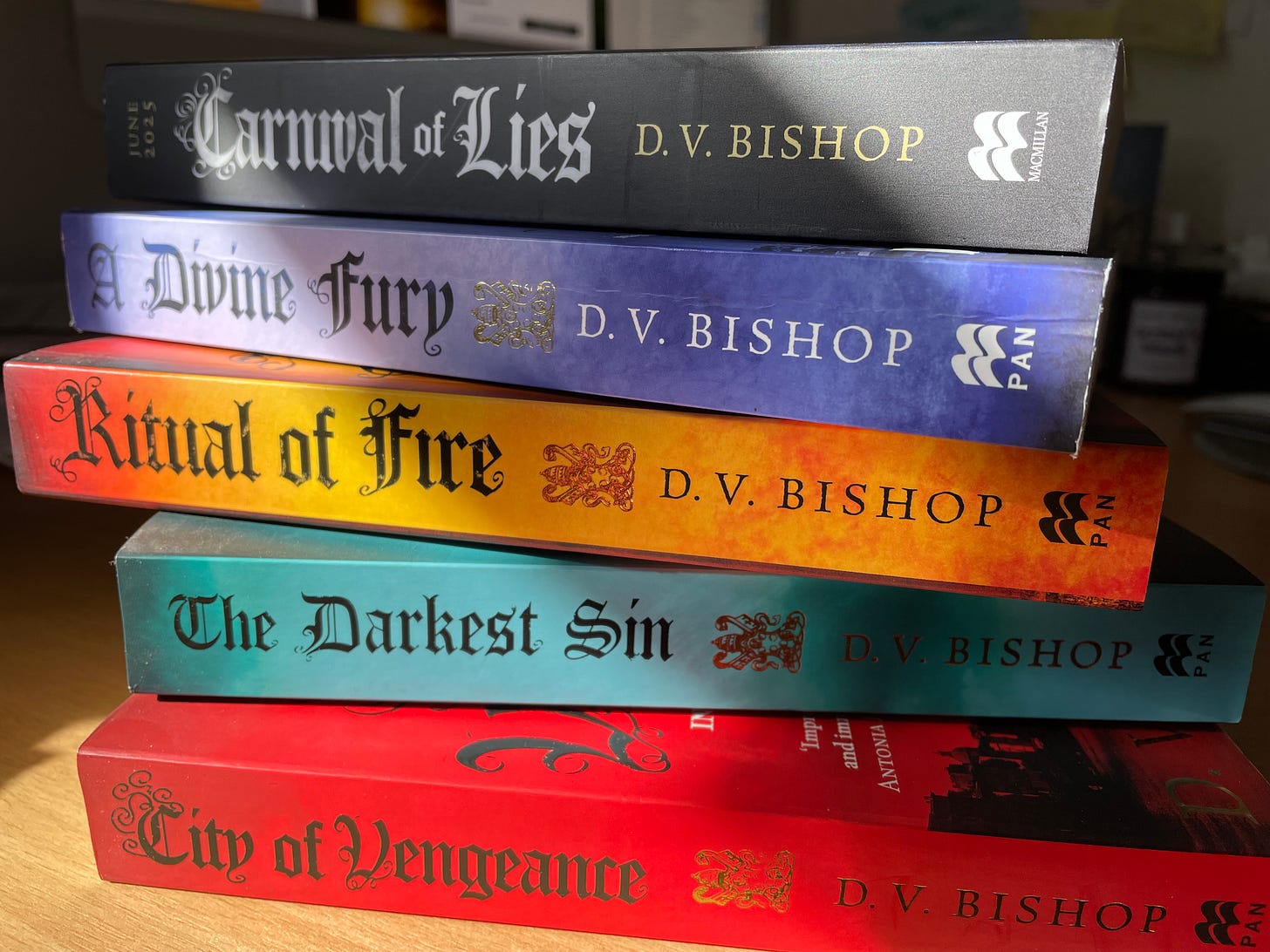Welcome to the free newsletter of David (D. V.) Bishop, author of the Cesare Aldo historical thrillers set in Renaissance Italy. This time: defining the midlist
The unheard majority?
Last week I mentioned two publishing industry terms: frontlist, which are newly released books; and backlist, titles that have been out at least a year. Backlist titles that keep selling are a boon for everyone. They make steady money for a publisher, and bookshops know to keep that title in stock as someone will buy it soon.
But what about writers? Well, there is another piece of publishing jargon which applies to many of them: midlist. But what is it, and how does somebody join the midlist? Can a author jump from midlist to the celebrated status of being a bestseller?
Let’s start by dispelling some myths about what constitutes a bestseller. I’m focusing here on fiction aimed at adults, rather than delving into non-fiction or books aimed at children and teenagers. Those markets have their own peculiarities, and I don’t pretend to know much about colouring books, air fryer guides or YA dystopias.
Here’s an odd fact: most weeks a hardback novel can hit the Sunday Times bestseller list by shifting as few as 1500 copies in seven days. Indeed, some novels achieve that bestseller status by selling as few as a thousand copies. Just 1000-1500 people buying your hardback in the same week could make you a Sunday Times bestseller – for life!
By way of context, every Cesare Aldo hardback published so far has sold at least 1500 copies – but none sold all of those in a single week, so I’ve yet to achieve the rarified status of being a bestselling author. (To make the bestseller lists with a paperback requires selling 6000 copies in the same week, a bigger ask for most authors.)
If a hardback novel is going to make the Sunday Times bestseller list, it will most likely do so the week it is published. Most new books are published on a Thursday therefore ir actually only has three days on sale in that first week. How does that hardback hit the list within such a limited window? The answer is usually pre-orders.
Pre-orders are the secret sauce
Authors spend months ahead of a new novel’s publication urging readers to pre-order it. Convince 1500 people to do so and you’ve a great chance of being a Sunday Times bestseller. You can pre-order my new novel Carnival of Lies here or here, by the way - it comes out in 50 days. Subtle, huh? That’s how authors drive up their advance sales.
Carnival of Lies comes out June 26th, pre-order your copy here.
Pre-orders are gold dust. They prove there is interest (or excitement, given enough pre-orders) in a forthcoming title. That encourages a publisher to put more effort into a new novel, it nudges bookshops to order more copies which gives people browsing in that shop a greater chance of stumbling on that new novel; it’s a virtuous circle.
There are other pre-order prompts. Sometimes a retailer will commission a special edition of the hardback, possibly with sprayed edges. The book might get selected for a limited edition print run, signed by the author. That can add hundreds, even thousands to pre-orders for some genres (romantasy is very hot right now).
Most special editions are pre-ordered, often months in advance, yet all pre-orders get counted against the week of publication. There are some novels that top the list for one week, selling thousands of pre-ordered special editions to collectors, yet only sell a few dozen next week. Nonetheless, that author is a Sunday Times bestseller for life.
My Cesare Aldo novels have been steadily building a readership, but I doubt they will ever become Sunday Times bestsellers without outside intervention, such as a special edition or being featured in a big media book club. I’d love that to happen, but I have a much more realistic aspiration: to become a midlist author. Being a skyrocket sensation would be great, but I’ll settle for the slow burn success too.
What is a midlist author?
Put simply, they are someone whose books sell steady, reliable numbers – not enough to appear on the bestseller lists, but sufficient to ensure their publisher makes a handy profit from each new novel. I’d guess most midlist authors earn out their contracts in good time, too, meaning they get royalties from book sales too. Everyone’s a winner!
Midlist authors tend to publish a new book a year (two, in some cases). This helps build a loyal readership eager to enjoy whatever that writer writes next. Midlisters often write series, which helps cement reader loyalty but can have downsides too. Over time, the author becomes their own brand – a guarantee of story quality.
According to Unsplash, this is what an author looks like! Photo by Darius Bashar
There is a perception that midlist authors don’t get much respect. They aren’t sexy new debuts with lots of attention and marketing, nor are they celebrated bestsellers. Instead, midlist authors are dependable bread and butter basics, often the backbone of a publishing house list. Realistically, not every author or book can be a bestseller.
The other challenge of being midlist is attaining that status. A single successful novel does not cut the mustard. The ability to earn out book after book, year after year is the definition. This requires a publisher to have faith in a writer’s midlist potential, to stick with an author who isn’t quickly earning out with their first few novels.
Successful authors with lengthy careers often mention they didn’t attain that success until their fifth or seventh or even ninth book. But to reach that point, it needed a publisher willing to keep backing them, even when numbers didn’t yet justify it yet. That is less common in a world of conglomerate publishing and cutthroat margins.
Am I a midlist author?
Having talked in generalities, let’s get specific. Am I a midlist author? Not yet, I would say, even though I’m drafting my sixth Cesare Aldo historical thriller and have earned out for the first two books in that series. If I can secure another contract after delivering Aldo six, then I can probably start calling myself a midlist author.
Here’s a cold fact: many authors don’t continue being published. Either their first few books don’t sell enough to justify another contract, or they ran dry of stories to tell, or fall out of love with writing and the challenges of being a writer. You don’t hear from authors no longer publishing because, well, they’re no longer publishing.
I walked away from prose fiction between 2008 and 2017. I was busy screenwriting and teaching and with life. But the urge to write fiction never left me and, eventually, I came back. Happily, my second stint in the author mines is proving more fulfilling than my first, so I plan to stick around for quite a few books yet.
Not everyone finds sufficient success to keep going through all the rejections and disappointments and heartbreaks. Being an author isn’t digging ditches or fighting wars, but it eats a lot of emotional labour and mental energy alongside your creativity. Not everyone has the circumstances or the opportunities necessary to sustain that.
I count myself lucky to have found (again) the thing I love doing, and even luckier that readers enjoy the stories I invent. Even if nobody was buying my books, I suspect I would keep writing. Getting the crazy from my head down on the page is good for me. Bestseller or midlist, successful or not, writing makes me happier. Onwards!
If you’ve been forwarded this newsletter by a friend, feel free to subscribe. But if you no longer wish to receive it, click unsubscribe at the bottom of the page.








I have purchased all of your previous Aldo novels, SIGNED, from Goldsboro Books in London (first edition, first printing). I have them shipped to Charleston, South Carolina, USA, direct from Goldsboro. I wait until Goldsboro lists them as pre-orders. The sooner you arrange with Goldsboro for signing copies, the sooner they MAY be listed for pre-order.
fascinating! Always wondered what midlist meant when it come to authors and books